
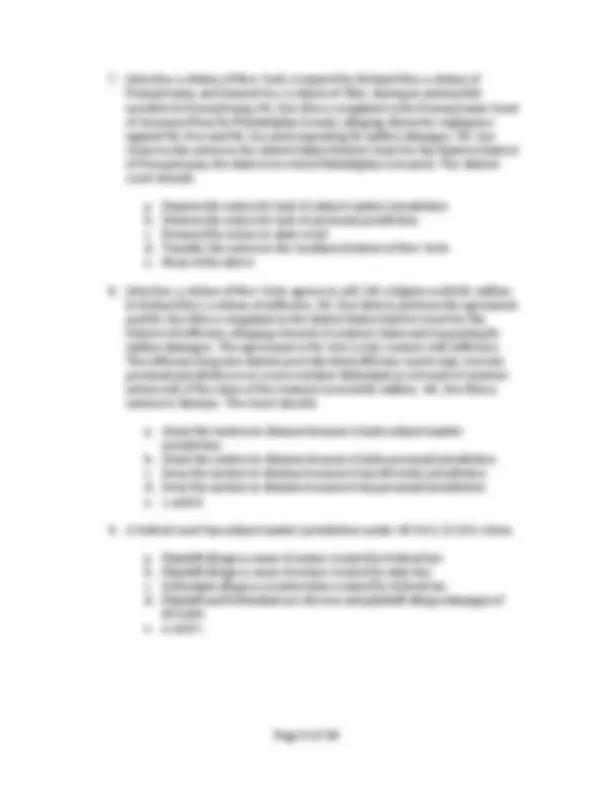
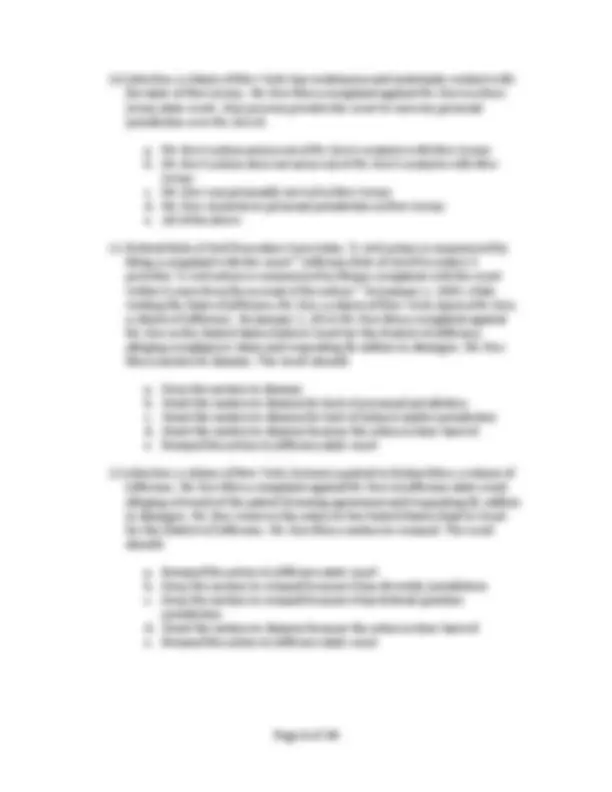
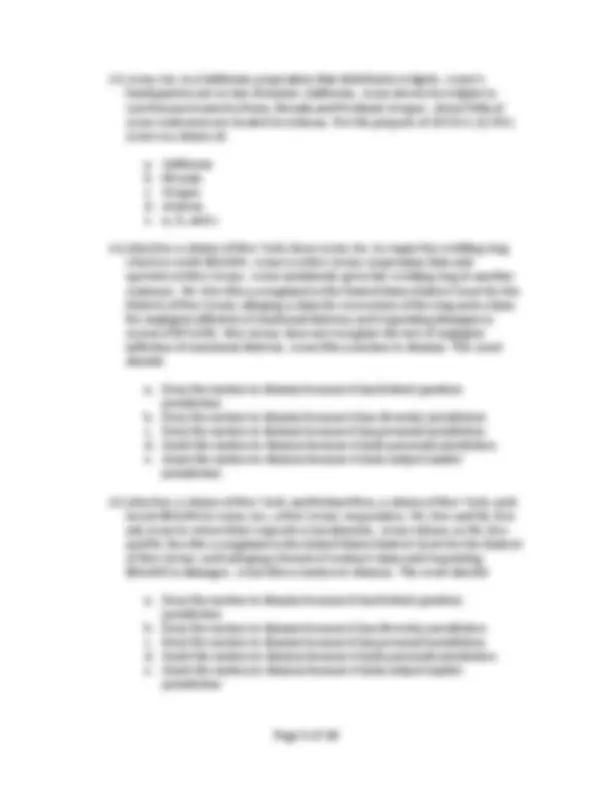
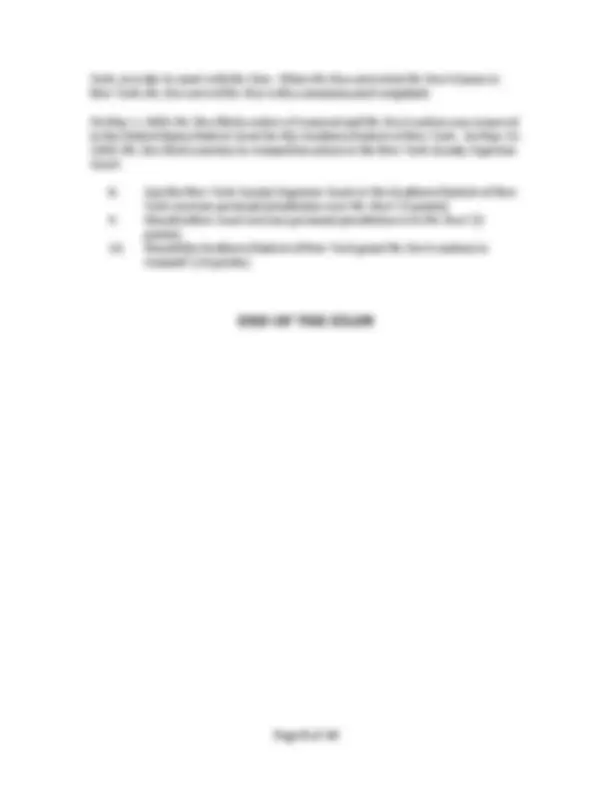
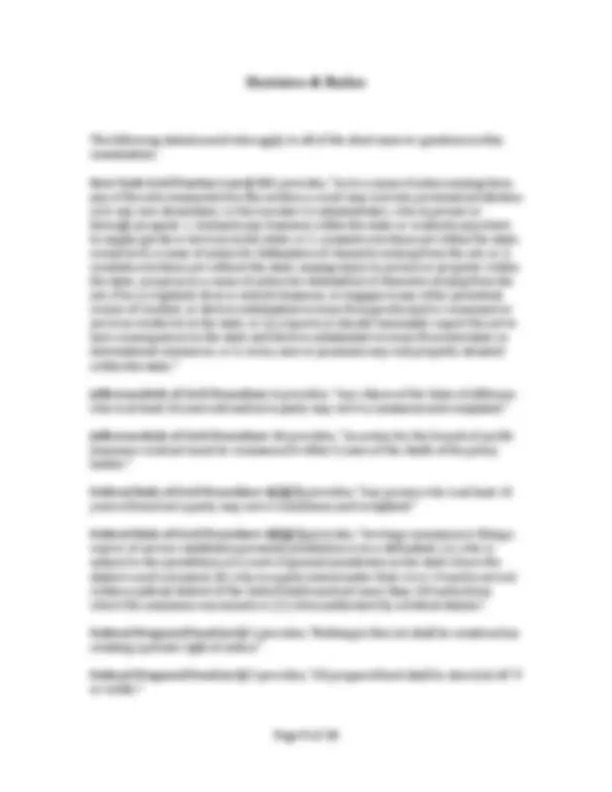



Study with the several resources on Docsity

Earn points by helping other students or get them with a premium plan


Prepare for your exams
Study with the several resources on Docsity

Earn points to download
Earn points by helping other students or get them with a premium plan
Community
Ask the community for help and clear up your study doubts
Discover the best universities in your country according to Docsity users
Free resources
Download our free guides on studying techniques, anxiety management strategies, and thesis advice from Docsity tutors
This is the Past Exam of Civil Procedure and its key important points are: Rules of Civil Procedure, Automobile Accident, Diversity Jurisdiction, Personal Jurisdiction, Systematic Contact, Accrual of Action, Interactive Features, Historical Style
Typology: Exams
1 / 10

This page cannot be seen from the preview
Don't miss anything!







a. New York. b. New Jersey. c. Connecticut. d. Federal common law. e. Federal Rules of Civil Procedure.
a. Diversity jurisdiction b. Federal question jurisdiction c. Personal jurisdiction d. All of the above e. None of the above
a. Diversity jurisdiction b. Federal question jurisdiction c. Personal jurisdiction d. b and c. e. None of the above
a. Southern District of New York b. Eastern District of Pennsylvania c. Northern District of Ohio d. District of New Jersey e. All of the above
a. Southern District of New York b. Eastern District of Pennsylvania c. Northern District of Ohio d. District of New Jersey e. b. and c.
a. Southern District of New York b. Eastern District of Pennsylvania c. Northern District of Ohio d. District of New Jersey e. b. and c.
a. Mr. Roe’s action arises out of Mr. Doe’s contacts with New Jersey b. Mr. Roe’s action does not arise out of Mr. Doe’s contacts with New Jersey c. Mr. Doe was personally served in New Jersey d. Mr. Doe consents to personal jurisdiction in New Jersey e. All of the above
a. Deny the motion to dismiss b. Grant the motion to dismiss for lack of personal jurisdiction c. Grant the motion to dismiss for lack of subject matter jurisdiction d. Grant the motion to dismiss because the action is time-barred e. Remand the action to Jefferson state court
a. Remand the action to Jefferson state court b. Deny the motion to remand because it has diversity jurisdiction c. Deny the motion to remand because it has federal question jurisdiction d. Grant the motion to dismiss because the action is time-barred e. Remand the action to Jefferson state court
a. California b. Nevada c. Oregon d. Arizona e. a., b., and c.
a. Deny the motion to dismiss because it has federal question jurisdiction b. Deny the motion to dismiss because it has diversity jurisdiction c. Deny the motion to dismiss because it has personal jurisdiction d. Grant the motion to dismiss because it lacks personal jurisdiction e. Grant the motion to dismiss because it lacks subject matter jurisdiction
a. Deny the motion to dismiss because it has federal question jurisdiction b. Deny the motion to dismiss because it has diversity jurisdiction c. Deny the motion to dismiss because it has personal jurisdiction d. Grant the motion to dismiss because it lacks personal jurisdiction e. Grant the motion to dismiss because it lacks subject matter jurisdiction
Fact Pattern # 2
John Doe was a citizen of the State of Jefferson. On January 1, 1995, Mr. Doe purchased a 10-year term life insurance policy with a death benefit of $200, from Acme, Inc., a Delaware corporation headquartered in New York, with branch offices in Arkansas, Jefferson, and Rhode Island. Mr. Doe’s policy listed the following beneficiaries: His wife, Dorothy Doe, a citizen of Jefferson (50%); his uncle, Richard Roe, a citizen of Arkansas (25%); and his nephew Peter Poe, a citizen of Rhode Island (25%).
On December 31, 2005, Mr. Doe died. On December 1, 2006, Acme refused to honor Mr. Doe’s life insurance policy. On December 15, 2007, Mrs. Doe, Mr. Roe, and Mr. Poe filed a complaint against Acme in the United States District Court for the District of Jefferson, alleging breach of contract. Mrs. Doe claimed damages of $100,000, Mr. Roe claimed damages of $50,000, and Mr. Poe claimed damages of $50,000. Mr. Poe personally served a summons and complaint on the manager of Acme’s branch office in Jefferson.
On January 15, 2008, Mr. Doe’s niece Sally Soe, a citizen of New York, filed a motion to intervene pursuant to Federal Rule of Civil Procedure 24. Ms. Soe claimed that Mr. Doe had intended to name her sole beneficiary of his life insurance policy. On January 31, 2008, Acme filed a motion to dismiss the complaint for improper service of process and a motion to dismiss the claims of Mr. Roe and Mr. Poe for lack of subject matter jurisdiction.
Fact Pattern # 3
John Doe is a citizen of New York. On January 1, 2000, Mr. Doe drove to Jamestown, North Dakota to see the World’s Largest Buffalo. After looking at the Buffalo, Mr. Doe purchased a corndog from a concession stand owned and operated by Mr. Roe, a citizen of North Dakota. Unfortunately, the corndog was infected with salmonella bacteria. Mr. Doe contracted salmonellosis and was hospitalized for 2 weeks.
On January 15, 2000, Mr. Doe filed a complaint against Mr. Roe in the New York County Supreme Court, alleging that Mr. Roe negligently stored his corndogs at 45˚ F in violation of the Federal Prepared Food Act and claiming damages of $75,000.
On April 1, 2000, Mr. Doe sent a letter to Mr. Roe, stating that he was interested in investing in Mr. Roe’s concession stand. On April 2, 2000, Mr. Roe drove to New
York, in order to meet with Mr. Doe. When Mr. Roe arrived at Mr. Doe’s home in New York, Mr. Doe served Mr. Roe with a summons and complaint.
On May 1, 2000, Mr. Roe filed a notice of removal and Mr. Doe’s action was removed to the United States District Court for the Southern District of New York. On May 15, 2000, Mr. Doe filed a motion to remand his action to the New York County Supreme Court.
New York Prepared Food Act § 10 provides, “A vendor of prepared food who violates any New York or federal standard governing the sale of prepared food is presumed negligent under this Act.”